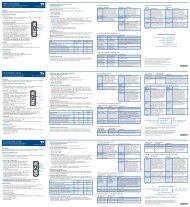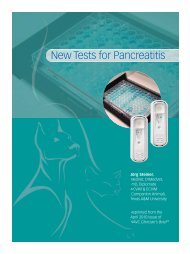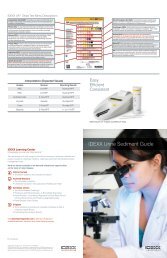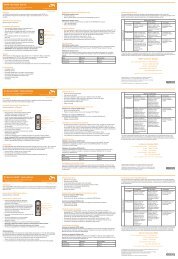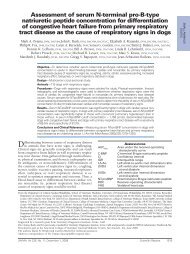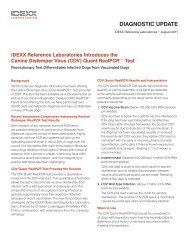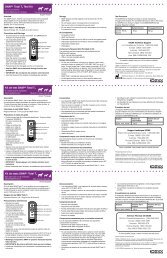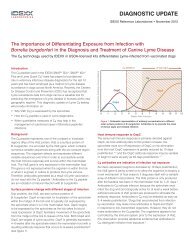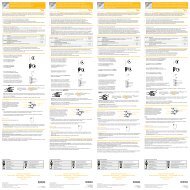Validation of IDEXX VetLab UA Analyzer and IDEXX UA Strips for ...
Validation of IDEXX VetLab UA Analyzer and IDEXX UA Strips for ...
Validation of IDEXX VetLab UA Analyzer and IDEXX UA Strips for ...
You also want an ePaper? Increase the reach of your titles
YUMPU automatically turns print PDFs into web optimized ePapers that Google loves.
<strong>Validation</strong> <strong>of</strong> <strong>IDEXX</strong> <strong>VetLab</strong> ® <strong>UA</strong> <strong>Analyzer</strong> <strong>and</strong> <strong>IDEXX</strong> <strong>UA</strong><strong>Strips</strong> <strong>for</strong> Veterinary SamplesW LePage; S Corey; T Hunt, PhD; P Wong, PhD; M Frye, DVMABSTRACT: To validate <strong>IDEXX</strong> <strong>UA</strong> <strong>Strips</strong> <strong>and</strong> the <strong>IDEXX</strong> <strong>VetLab</strong> ® <strong>UA</strong><strong>Analyzer</strong> <strong>for</strong> veterinary samples against the reference instrument: BayerCLINITEK Atlas ® 5001B (Elkhart, IN). 203 urine samples (115 canine, 66feline <strong>and</strong> 22 equine) were run on both systems. The agreement betweenthe reference, the <strong>IDEXX</strong> <strong>UA</strong> strips visual read <strong>and</strong> the <strong>IDEXX</strong> <strong>VetLab</strong> ® <strong>UA</strong>was greater than 90%.INTRODUCTION: It is well established that urinalysisis a key component <strong>of</strong> the minimum diagnosticpr<strong>of</strong>ile <strong>for</strong> all sick patients, along with chemistry <strong>and</strong>hematology. There is also general consensus that aurinalysis should be conducted as close as possibleto the time <strong>of</strong> collection to increase the accuracy, thusmaking it an ideal in-house test. <strong>IDEXX</strong> <strong>UA</strong> <strong>Strips</strong> arethe only urine dipsticks validated <strong>for</strong> veterinary useon canine, feline, <strong>and</strong> equine urine. The strips can beread visually or with the <strong>IDEXX</strong> <strong>VetLab</strong> ® <strong>UA</strong> <strong>Analyzer</strong>.The objective <strong>of</strong> this study was to compare the <strong>IDEXX</strong>results (visual <strong>and</strong> reader) to the reference instrument(Bayer Atlas).There are two types <strong>of</strong> results from a photometric test:quantitative <strong>and</strong> semi-quantitatitive. For quantitativetests such as blood glucose measurement meters,color development on the test area is directlyproportional to the concentration <strong>of</strong> the analyte in thesample due to test device design <strong>and</strong> concentrationcalculation algorithm (see figure A). For semiquantitativetests such as the urinalysis strip screeningtest, the development <strong>of</strong> the reaction color on the testpads is influenced by different variables, includingsample h<strong>and</strong>ling, composition <strong>of</strong> the urine sample,intrinsic urine color, urine density, <strong>and</strong> urine volume onthe test paper (see figure B). Although urine analyzersmeasure the color intensity <strong>of</strong> the test strip inreflectance units with high precision, they are not ableto eliminate all influences on the color developmentas described above. There<strong>for</strong>e, the urine analyzerindicates measurement results only in concentrationranges (semi-quantitative) in contrast to glucosemeters or other instruments. There<strong>for</strong>e, <strong>for</strong> this study,the acceptance criterion was that all compared testmethods must have > 85% agreement <strong>of</strong> resultswithin +/– 1 color block.Color Intensity120100806040200Analyte ConcentrationFigure A—A quantitative test showing the direct responsebetween analyte concentration <strong>and</strong> color intensity.Color Intensity120100806040200Analyte ConcentrationFigure B —A semi-quantitative test showing that thecolor intensity that develops in response to analyteconcentration is not very precise because <strong>of</strong> the influence<strong>of</strong> external factors such as the intrinsic color <strong>of</strong> the urinesample <strong>and</strong> sample h<strong>and</strong>ling.
MATERIALS AND METHODS: Samples <strong>of</strong> canine,feline <strong>and</strong> equine urine (~ 3 mls each) were collectedat three veterinary clinics. A total <strong>of</strong> 203 samples wereanalyzed (115 canine, 66 feline <strong>and</strong> 22 equine). Thesesamples were from healthy as well as sick patients.For each sample, 2 <strong>IDEXX</strong> <strong>UA</strong> strips were analyzed:one <strong>for</strong> a visual read <strong>and</strong> one <strong>for</strong> an instrument read(<strong>UA</strong> <strong>Analyzer</strong>).The samples were also run on the referenceinstrument (Bayer Atlas). To run the Atlas, the sampleswere dispensed into Urin-Tek sample tubes <strong>and</strong>loaded onto the sample carousel. After the sampleIDs were entered into the instrument, the sample wasautomatically dispensed onto the reagent strips, thestrips were incubated <strong>and</strong> the results printed.RESULTS: The results from the <strong>IDEXX</strong> <strong>UA</strong> <strong>Analyzer</strong>are semi-quantitative in nature <strong>and</strong> are there<strong>for</strong>e givenin result ranges or color blocks. Since these resultranges <strong>for</strong> each analyte are overlapping (see theexample below), results in the expected concentrationrange <strong>and</strong> in both neighboring ranges (+/– 1 colorblock) are considered acceptable.Reflectance100%90%80%70%60%50%40%30%20%10%0%neg50 mg/dLGlucose100 mg/dL300 mg/dL1000 mg/dL1 10 100 1000 10000Analyte ConcentrationDISCUSSION: There was a high level <strong>of</strong> agreementbetween the results from the <strong>IDEXX</strong> <strong>UA</strong> <strong>Analyzer</strong> <strong>and</strong>the visually read <strong>UA</strong> <strong>Strips</strong> as well as to the referenceinstrument, the Bayer Atlas. In two cases, there weregross disagreements between the <strong>IDEXX</strong> <strong>UA</strong> <strong>Analyzer</strong><strong>and</strong> the Bayer Atlas. For bilirubin, the <strong>UA</strong> <strong>Analyzer</strong> hada negative result, while the Atlas’s result was “large,”a 3– concentration range difference. When the samplewas sent to a reference lab <strong>for</strong> analysis, the resultsconfirmed the <strong>UA</strong> <strong>Analyzer</strong>’s result. The second casein which there was a disagreement between the twoanalyzers involved Protein. The <strong>UA</strong> <strong>Analyzer</strong> had anegative result, while the Atlas had a “>300” result, a4– concentration range difference. Again, the referencelab result confirmed the <strong>UA</strong> result.Because all the comparative results had a greater than85% agreement, the acceptance criteria have beenmet <strong>for</strong> the validation <strong>of</strong> canine, feline <strong>and</strong> equine urinesamples <strong>for</strong> <strong>IDEXX</strong> <strong>UA</strong> <strong>Strips</strong> <strong>and</strong> the <strong>IDEXX</strong> <strong>VetLab</strong> ®<strong>UA</strong> <strong>Analyzer</strong> against the reference instrument, BayerAtlas.CONCLUSION: The <strong>IDEXX</strong> <strong>UA</strong> <strong>Analyzer</strong> <strong>and</strong> <strong>UA</strong><strong>Strips</strong> provide accurate <strong>and</strong> reliable semi-quantitativeurinalysis test results compared to the Bayer Atlasreference method <strong>for</strong> canine, feline <strong>and</strong> equinesamples. The <strong>IDEXX</strong> <strong>VetLab</strong> <strong>UA</strong> <strong>Analyzer</strong> <strong>and</strong> <strong>UA</strong><strong>Strips</strong> allow practitioners to <strong>of</strong>fer their clients a morecomplete diagnostic pr<strong>of</strong>ile by running a quick <strong>and</strong>easy in-house urinalysis test.The agreement between the <strong>IDEXX</strong> <strong>UA</strong> <strong>Strips</strong> visualresult, the <strong>IDEXX</strong> <strong>VetLab</strong> ® <strong>UA</strong> analyzer result <strong>and</strong> thereference instrument result are all summarized in thefollowing table:Visual vs.<strong>UA</strong> <strong>Analyzer</strong>Visual vs.Atlas<strong>UA</strong> <strong>Analyzer</strong>vs. AtlasBilirubin 94% 98% 99%Blood 99% 94% 92%Glucose 99% 97% 98%Ketone 99% 100% 100%Leukocytes 98% 97% 98%Protein 96% 97% 90%Urobilinogen 98% 100% 96%pH 100% 96% 98%One <strong>IDEXX</strong> DriveWestbrook, Maine 04092 USAidexx.com© 2006 <strong>IDEXX</strong> Laboratories, Inc. All rights reserved. • 09-65804-00 (9)<strong>IDEXX</strong> <strong>UA</strong> <strong>and</strong> <strong>IDEXX</strong> <strong>VetLab</strong> are trademarks or registered trademarks<strong>of</strong> <strong>IDEXX</strong> Laboratories, Inc. in the United States <strong>and</strong>/or other countries.



